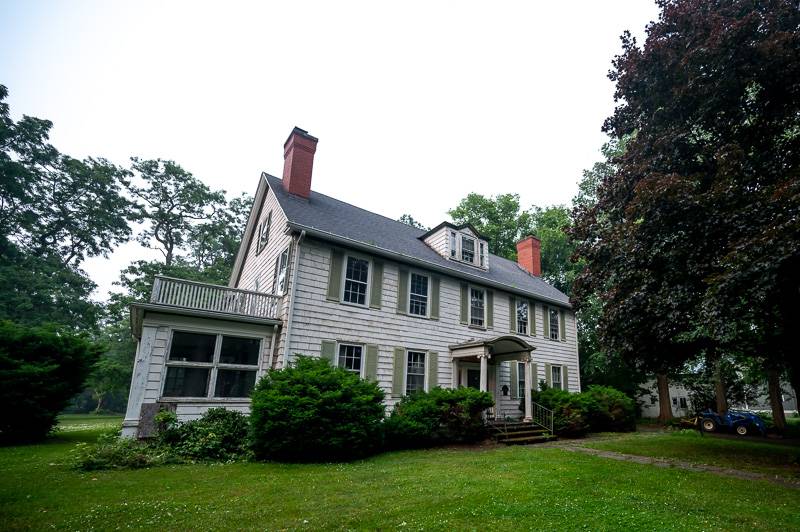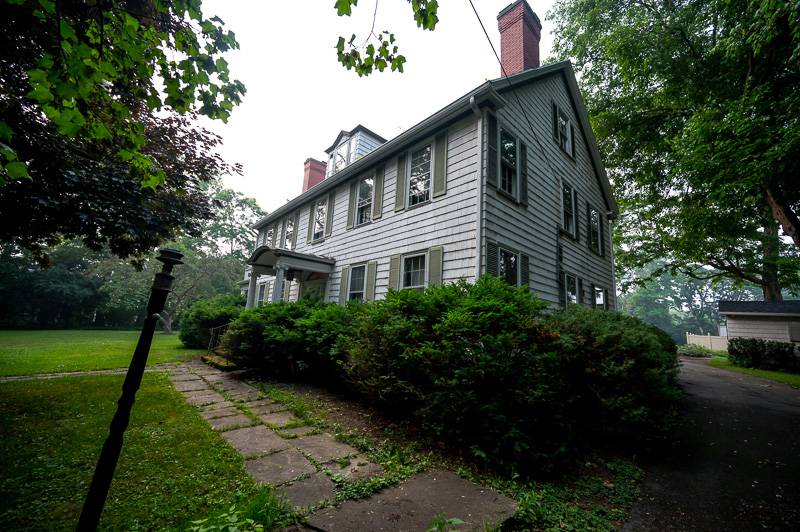SmartDESIGN seeks rezoning to move into Mix Place, restore its 'glory'

Photo by Howard Owens.
When Ed Smart initially saw his prospective new abode at 4 Mix Place, there was an obvious misgiving about the place.
“The first time I walked through it, it was raining inside the building,” he said during an interview with The Batavian Wednesday. “We appreciate beautiful buildings, so I'd love to see this thing restored to its glory and then some. It's just a beautiful piece of property. And, you know, over the time that I have owned it, I've invested in it, even without being able to use it, until I know I can use it for the use I want.”
And what he wants, which he has officially requested as smartDESIGN Architecture with a letter to the city, is to move his architectural company into the premises that are zoned residential 1A and obtain a zoning code update to amend that to residential 3 to allow for professional offices in that section of the city.
Smart is requesting to amend a section in the zoning code to read “offices for attorneys, physicians, dentists, another similar professional, not exceeding four offices in a single structure.” The current code does not include “and other similar professionals” in that section.
City Manager Rachael Tabelski recommended to City Council this week that if the group opted to grant the request, it may also want to consider including 1 Mix, a single-family residence, and 3 Mix, a two-building, eight-unit apartment building, to bring them into the R-3 district for zoning compliance.
Smart wants to bring his staff of about 11 people plus himself — give or take, depending on business needs at any given moment — and set up shop at the Mix Place site.

Formerly a residence with ample grounds and gardens, trees and smaller buildings, the site was built in 1809 by Ebenezer Mix, and has been a single-family residence and fixture for decades, until the last several years, when left unoccupied it has been vandalized, heavily damaged, and then discovered by Smart. It failed to sell at an auction before he made an offer and purchased it about two years ago, he said.
“I fixed quite a few things that needed attention. There were thieves and vandals that got in there and stole the copper, and they left a big hole in the roof where they ripped the vent stack out of the roof water had just been dumped in there, and it completely destroyed two rooms, and it partially destroyed a couple of others.
"So I fixed the roof, it was all hot water heat before, which of course, was covered, so I got some heat in there and then also ran dehumidifiers around the clock for months, actually. So then dried it out. And so it's been warm and dry,” he said. “And, then also, we've done some maintenance around the property. So, again, just trying to be a good neighbor, before we can get in there, we took out a whole lot of dead trees, where limbs were falling and things like that, but maintaining the attractive trees that are in there, with no intention of clear-cutting like that it’s too beautiful of a yard. We recently put a roof on the shed … and are working on a roof now for the little gazebo in the back, which is a beautiful little building, so I keep trying to keep things neat over there.”
He sent out a letter to the surrounding neighborhoods earlier this month to introduce himself and his intentions and to invite residents the opportunity to call or email him with questions, comments and concerns. To date, he has only heard positive feedback, he said.
SmartDESIGN does not get a lot of in-person visitors, he said, and oftentimes staff is off-site to tend to customer needs, so he does not expect there to be an issue with traffic. One employee works in Arizona, two others in Central New York that commute one day per week, and remote work is encouraged, he said. The company has been located on Harvester Avenue in Batavia for 19 years.
His firm “delivers architectural and design services throughout the United States,” he said in his application. “On an average day, there will be five to seven people in the office. With a full office, parking for 10 vehicles would be necessary and can be accommodated at the property.
His intent is to maintain the historic character of the building, he said, including “all roofs, windows, doors, siding and shutters” that will be repaired, and “the entire building will be painted with a “historically-appropriate color palette.”
Despite that first glimpse of a raining interior, why here?
“So when I made the decision that I was going to start looking, (4 Mix Place) popped up on our radar, and we went and took a look … nobody else really had the will to take this project on. There's certainly people that have the finances, but those people didn't have the will. So this is something where I really, really liked this building, I really liked that spot in the city. I think our use is a good fit for the community, and I think we can bring that building back to its past glory,” Smart said. “I would like to have a community opening next year to celebrate our 20th anniversary. We would love to celebrate it in that building.
“One of the things I’d like to emphasize is that anything that we do in that space isn’t anything that couldn’t be undone in the future. This house has been there for 200 years, and it’s going to have a life after me, but it will be my final home and will be here for the life of my business.”
Smart encourages neighborhood residents to contact him with comments at (585) 345-4067, Ext. 112 or by email at esmart@smartdesignarchitecture.com.
City Council is expected to vote on his request, which may include being forwarded to the city’s Planning & Development Committee, during its next meeting on July 10.
